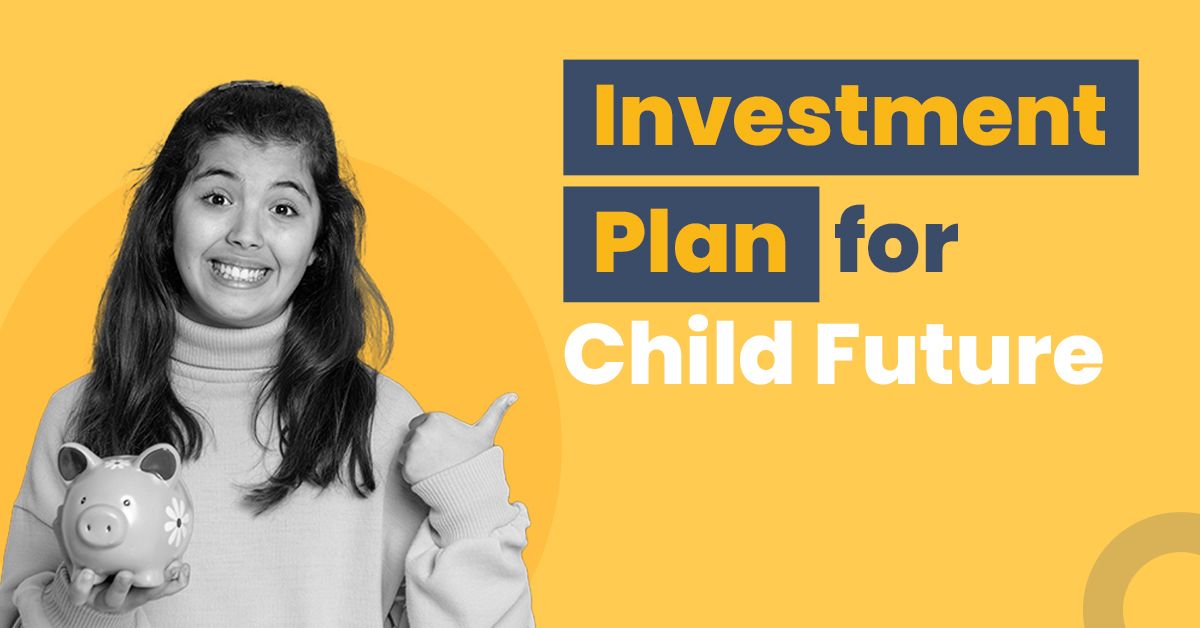Best Investment Plan for a Child’s Future


Gifting a secure future for your child is a major concern for a parent. Ensuring financial security and saving enough money, which your child can use when they grow up, takes work. This becomes more significant, considering inflation and the constantly rising education costs.
So how can you ensure financial safety for your child? It’s simple – choose the best investment plan for your child’s future and start investing when they are young. Starting early will allow you more time to build up a sufficient corpus, which your child can use when they grow up, to meet their expenses related to higher education, wedding, etc.
Several options are available when selecting an investment plan for your child’s future. Your choice must depend on your child’s future goals and budget. This blog covers some of the best options available. You must select an investment scheme after comparing the benefits and drawbacks of all available options.
7 Best Investment Options for a Child’s Future
Below is a list of investment options for a child’s financially secure future.
- Public Provident Fund
- Sukanya Samriddhi Yojana
- Post Office Time Deposit
- Post Office Monthly Income Scheme
- National Savings Certificate
- Equity Investments
- Gold
- Stocks and Mutual Funds
- Unit Linked Insurance Plans (ULIPs)
Public Provident Fund
Public Provident Fund (PPF) is a long-term investment option to safeguard your child’s future. You can open a PPF account with an initial deposit of INR 500. The maximum amount you can deposit in a year is INR 1.5 Lakhs. A PPF has a 15-year maturity period, and you have to make deposits at least once a year. Depositing a lump sum or paying in instalments is also possible under this investment option. A PPF offers an interest rate of 7.1% per annum. This rate is set to change every quarter and is fixed by the government. This is one of the best investment plans for a child’s future for people looking for safe investments with long-term returns.
Benefits
- From 3rd to 6th year of opening the account, a PPF account holder can avail of loans against their PPF account. The eligible limit for this loan is 25% of the account balance.
- Partial withdrawal is allowed after the completion of five financial years. However, you cannot withdraw the entire amount. The amount is capped at the lower of the two – 50% of the balance at the end of the fourth financial year or 50% of the balance at the end of the preceding year.
- PPF returns are not affected by market fluctuations, as it is a fixed-income scheme
- You can avail of tax benefits as per Section 80C of the Income Tax Act, as PPFs fall under the EEE (Exempt-Exempt-Exempt) category. This means all deposits made can be deducted from tax. You receive a tax-free interest amount and maturity benefit. Because of these tax benefits, the returns are relatively higher than they look. For example, a 7.1% return under PPF is essentially 10.14% return for any other debt instrument.
Eligibility Criteria
- You must be an Indian citizen above 18 years old.
- Only one account can be opened per individual.
- Parents and legal guardians can open a minor’s PPF account on their behalf.
Sukanya Samriddhi Yojana
Sukanya Samriddhi Yojana is a government-led scheme aimed at benefiting girl children below ten. You can open an account offline or online with minimum and maximum deposits of INR 250 and 1.5 Lakhs, respectively.
The policy has a maturity period of twenty-one years from the account opening date. The account closure may also be permitted before that if the account holder reaches 18 years of age and is getting married. However, 50% of premature withdrawal is allowed once your girl child reaches the age of 18 and needs funds to pursue higher education. Furthermore, it offers a facility for opening two accounts if you have two girls in your family. Let us look at some benefits that make this one of the best investment plans for a child’s future.
Benefits
- Depositors can earn an interest rate of 8.2% with minimum deposits. This rate is revised by the government quarterly
- 50% of the deposited amount can be withdrawn after the girl child attains the age of 18 for two reasons: wedding expenses or education costs.
- Your long-term investments under SSY are eligible for EEE (Exemption- Exemption- Exemption) tax deduction status. As a result, your contribution into the scheme (upto INR 1.5 lakhs per year), any interest earned on the investments and the maturity amount, are all safe from taxation.
- Even after maturity, if the account is not closed, interest shall be payable till the final closure of the account.
- You can transfer the SSY account from one part of the country to another (bank/post office) in case of your transfer.
Eligibility Criteria
- You must be an Indian citizen.
- You must be a legal guardian of a girl child.
- The girl child must be below ten years when opening an account.
Post Office Time Deposit
The Post Office Time Deposit scheme allows you to open four types of accounts depending on the tenure, i.e. 1, year account, 2-year account, 3-year account and 5-year account. You can also open a joint account held by a maximum of three people. It offers an interest rate of 6.9% to 7.0% for accounts with a tenure of 1-3 years and 7.5% for accounts with a term of 5 years. Moreover, the scheme is one of the best investment plans for a child’s future as it requires a minimum deposit of INR 1000 and multiples of INR 100.
You can opt for a premature withdrawal after six months with this scheme. However, the amount will be auto-renewed if you don’t withdraw it after maturity. The renewal amount will have the same tenure as the previous one, with the applicable interest rate on the maturity date.
Benefits
- Being a government-backed scheme, the post office time deposit investments are safe from market fluctuations, and hence, the returns are guaranteed.
- You can transfer your account from one post office to another.
- A 10-year-old minor can open an account in this scheme, but it has to be managed by their legal guardian
- Tax deductions under Section 80C of the Income Tax Act are applicable for up to INR 1.5 lakhs, but only if the account has been active for 5 years.
- Nomination facility is available.
- A Time Deposit account may be pledged or transferred as security to the following authorities:
- The President of India/Governor of the State.
- RBI/Scheduled Bank/Co-operative Society/Co-operative Bank.
- Corporation (public/private)/Government Company/Local Authority.
- Housing finance company.
Eligibility Criteria
- You must be an Indian resident and above 18.
- Only a parent/guardian can open the account on the minor’s behalf.
Post Office Monthly Income Scheme
POMIS, with its monthly income-generating facility, is one of the best investment plans for a child’s future for people who need steady monthly returns. In POMIS, you can invest as minimum as INR 1000 to INR 9.0 Lakhs for revenue at 7.4% interest. This rate is revised by the government every quarter. Furthermore, like the Post Office Time Deposit, POMIS allows for a joint account with a maximum deposit limit of INR 15 Lakhs. However, the maximum deposit amount for a minor account is INR 3 Lakhs. While the scheme has a five-year lock-in period, you can opt for premature withdrawal after the end of 1 year by paying a penalty fee.
Benefits
- You get fixed monthly income in the form of interest earned by your deposit in POMIS
- Being a sovereign scheme, your investments are completely safe
- You can easily transfer your POMIS account from one post office to another.
- POMIS offers a nomination facility.
Eligibility Criteria
- You must be an Indian resident above ten years old.
- NRIs are not allowed to open an account.
- You can open an account for a minor who has completed ten years of age.
- Minors can access the fund only after completing 18 years of age.
National Savings Certificate
If you are looking for low-risk investments, NSC is an ideal investment plan for a child’s future with a tenure of 5 years. You can avail of this investment scheme with a minimum deposit of INR 1000 and make further deposits in multiples of 100. You will receive returns at an interest rate of 7.7%. This interest rate is notified by the government every quarter. However, you get this interest only after maturity.
Benefits
- The certificate is transferable from one person to another.
- You can use your NSC as collateral to avail of loans.
- Nomination facility available
- You can continue the investments even after maturity.
- Applicable tax benefits of up to INR 1.5 Lakhs under Section 80C of the Income Tax Act
- Reinvesting interest generates compounding benefits without purchasing a new certificate.
Eligibility Criteria
- You must be an Indian citizen above 10 years of age
- An investment can be made with another adult or on behalf of a minor.
- Hindu Undivided Families, Trusts, Non-resident Indians, Public, and Private limited companies are not allowed to invest in National Savings Certificate.
Equity Investments
Equity investments allow you to invest in company shares and gain ownership. The value of these shares fluctuates as per market conditions. You can profit from this investment by selling your shares when their market value increases. Equities are a great way of building a corpus for your child that they can use to fulfil their future financial needs. However, equity investments are highly risky because equities are subject to market risk. So, if you are a risk-tolerant investor, this investment is the best investment plan for a child’s future.
Benefits
- Equity investments have the potential to earn higher returns on your investments
- These investments are highly liquid, meaning your money isn’t locked away like other investments.
- As a shareholder of the company, you get voting rights in most decisions related to the company
- You can mitigate your risks by following a strategic portfolio diversification
Eligibility Criteria
There are no such eligibility criteria in equity investments. Anyone with a risk-bearing capacity can invest in equity investments.
Insurance Policies
Several insurance companies offer child-specific insurance policies that provide life cover and death benefits. The insured must pay a regular premium, and the compounded amount is given as a lump sum at maturity.
Benefits
- Insurance reimbursement can be used to cover any unforeseen expenses such as education or health.
- Insurance policies also offer a tax deduction for the premium paid under section 80C of the Income Tax Act 1961.
- Additionally, all benefits gained, including maturity and death, are exempt from income tax up to certain limits.
Eligibility Criteria
The general eligibility criteria to apply for term insurance are:
- The applicant must be between 18-65 years.
- The applicant must be an Indian citizen.
- The applicant must undertake the required medical tests.
- The applicant must submit the necessary documents, including pay slips.
- For child-specific plans, the minimum entry age is after birth, the maximum entry age is 12, and the maximum maturity age is 25.
Gold
Due to its appreciating nature, gold is a good hedge fund investment that can hold up against inflation. Apart from jewellery and coins, there are now digital options in gold investment, such as GOLD ETFs (Exchange Traded Funds), mutual funds, and SGBs that can be traded electronically.
Benefits
- Digital gold investment is safe as they come with no additional security or storage cost.
- There are no making or wastage charges in gold investment.
- Gold investment is more liquid as you can sell the mutual fund or ETF on the stock exchange and buy physical gold.
Eligibility Criteria
Residents, Hindu Undivided Families and minors who invest jointly with adults are eligible to invest in gold. The primary documents required for gold investment are identity proof (passport, PAN card, driver’s license etc.) and address proof (passport, utility bill etc.).
Stocks and Mutual Funds
Stocks are risky investments but offer high returns in the long run. Two types of mutual fund investment – lump sum payment or a Systematic Investment Plan (SIP) are available. In SIP, a certain amount is set aside from your account each month until it reaches a specific target and is invested in a mutual fund. There are hybrid mutual funds for children as well that give the option to the investor to choose debt or equity, or both based on their risk appetite. Mutual funds are ideal for meeting your child’s long-term financial goals.
Benefits
- Both stocks and mutual funds generate good returns (between 12% to 16%) over an extended period in the long run.
- There are multiple options in mutual funds, such as small/mid/large cap, debt funds, equity funds, etc.
- Investing in SIP helps individuals to manage volatile markets in the long term.
- Stock and mutual fund investment can help to create a corpus fund for your child.
- Since mutual funds do not have any lock-in, you can opt for partial withdrawals if required.
Eligibility Criteria
To invest in mutual funds, the investor must open an account with the fund house or link his existing bank account to the fund house. He must also complete the KYC, fill in the application form, and submit identity and address proof documents.
United Linked Insurance Plans (ULIPs)
ULIPs combine the features of investment and insurance. You pay regular premiums, but a part of the premium is invested in specific market-linked instruments. It is a great child investment plan as it can help you meet the child’s marriage or education needs. In the event of the policyholder’s unfortunate demise, the child will receive a lump sum according to policy terms. Some plans even come with a premium waiver where the child gets periodic payments for educational needs.
Benefits
- ULIPs give greater returns than traditional investment methods and are ideal for your child’s long-term needs.
- As a part of the ULIP premium is invested in capital market funds, there are more chances of generating returns.
- Your child is eligible for the insurance payout in case of your untimely death, securing their financial position.
- ULIP plans to invest in higher-return equity markets than other insurance types.
Eligibility Criteria
To invest in ULIP, the policyholder must be 18 years or older, the maximum age is 60 years, and the maturity age is a maximum of 75 years. ULIP child plans have one year as the minimum entry age, 60 as the maximum entry age, and years minimum maturity age will be 18 years.
Bottom Line
After going through the above-mentioned best investment plans for a child’s future, you must know which one is the right choice for you. While some plans offer a guaranteed return, some come with a risk and provide higher returns. Therefore, analyse your financial abilities and your child’s future goals and invest in a plan that suits your requirements.
Frequently Asked Questions
What is a child’s life insurance plan?
Child life insurance is one of the best investment plans for a child’s future in India for people looking for financial security for their children. It offers investment and insurance benefits. You can invest in these plans and provide your child with a financial cushion in case of sudden demise. The investments are helpful for your child’s future milestones.
What is an ideal investment period when investing in a child plan?
When choosing the best investment plan for a child’s future, carefully consider the duration or investment period. The ideal period depends on when you start investing and your investment goals. For example, if you are planning for a child’s higher education, the investment period should be such that the plan matures before the higher education starts.
What documents are necessary to apply for a child investment plan?
The documents typically needed for child investment plans are proof of age, proof of address, proof of identity, and proof of parents’ income.
Is there an age limit for a child investment plan?
The age limit for the child investment plan depends on the plan chosen. For example, it is under 10 for the SSY plan, 18 for ULIPs, etc.
Do child investment plans have tax benefits?
Most investment plans for children have tax benefits. The premiums and the maturity amounts are exempt from tax under Section 80D of the Income Tax Act.
Can children invest in mutual funds?
A child can also invest in mutual funds via a parent or guardian who can operate the mutual fund until the child turns 18.
How to invest for a 7-year-old child?
To invest for a 7-year-old child, you can opt for Sukanya Samriddhi Yojana for a girl, invest in SGBs on behalf of your children and opt for bank deposits as well.
What are the benefits of investing in a child plan?
There are various benefits of investing in child plans including:
1. Helps to save for future goals,
2. Education cover,
3. Can be a collateral against loans,
4. Help as a coverage in case of emergencies, etc.
Can I buy shares for my child?
Yes, you can buy shares on behalf of your child. As per the Companies Act, 2013, any citizen of any age can own shares of listed companies. Hence, minors can have Demat accounts to their name but cannot trade shares via that account.




